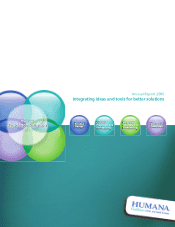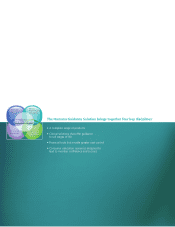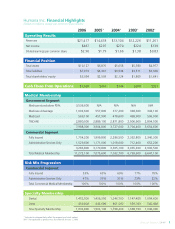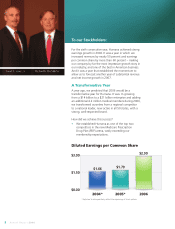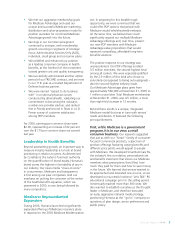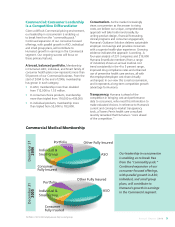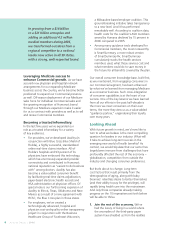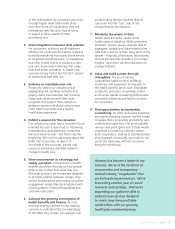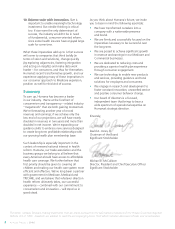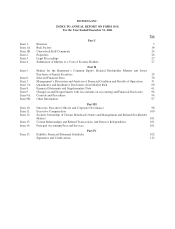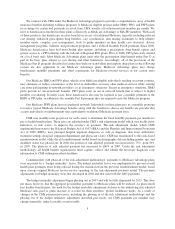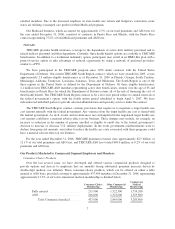Humana 2006 Annual Report Download - page 9
Download and view the complete annual report
Please find page 9 of the 2006 Humana annual report below. You can navigate through the pages in the report by either clicking on the pages listed below, or by using the keyword search tool below to find specific information within the annual report.
2Annual Report 2006 7
of the marketplace. As consumers pay more
through higher deductible health plans
and other forms of cost-sharing, they will
increasingly seek the value they’ve come
to expect in other aspects of their
purchasing lives.
2. Drive integration toward a total solution.
For consumers, solutions are all-important.
Whether it’s a telecommunications company
bundling everything from basic phone service
to on-demand entertainment, or megastores
that offer a wide variety of products under
one roof, buyers want offerings that make
their lives better and easier. In health care,
consumers have had to hunt to fi nd “pieces”
of solutions as best they can.
3. Embrace an inevitable new role.
Those who defi ne our industry only as
aggregating risk, building networks and
paying claims have less than half the story.
Today and tomorrow we’ll offer tools,
programs and support that underpin a
guidance-partner role that produces lower
costs, better outcomes and a quality
health-plan experience.
4. Exhibit a passion for the consumer.
Our industry has never had a consumer focus,
primarily because it never had to. Observing,
understanding and listening to consumers
will soon become vital – but that’s only the
beginning. We must be passionate about the
belief that consumers, as drivers of
two-thirds of the economy, are the only
means to achieving sustainable systemic
change in health care.
5. View consumerism as a strategy, not
simply a product. Consumerism in health
benefi ts should be more about how people
think and act rather than what they buy.
Although products are increasingly designed
to promote positive behavior change, they
cannot by themselves drive lasting consumer
engagement unless they are integrated with
clinical guidance, fi nancial forecasting and
consumer education.
6. Advance the growing convergence of
health benefi ts and fi nance. As costs
and cost-sharing continue to rise, helping
consumers understand the tax advantages
of the HSAs they choose, for example, will
produce savvy decision-making likely to
carry over into the “use” side of the
choose-fi nance-use equation.
7. Maximize the power of data.
Health plans are at the center of the
health system’s datafl ow. While protecting
members’ privacy, we are uniquely able to
aggregate, analyze and draw insights from
data that is sent to us from every point in the
system – hospitals, pharmacies, laboratories,
doctors and specialty providers. From these
insights, consumers can be empowered to
change behavior.
8. Value and build success through
intangibles. The era of valuing
corporations based on land, buildings,
machinery and equipment is long past. In
the health benefi ts sector, such intangibles
as patents, processes, knowledge, brand
and human capital increasingly differentiate
successful companies and lead to solutions
for consumers.
9. Find opportunities to standardize
connectivity. An ATM card works anywhere
because the banking industry had the insight
to realize that a proprietary productivity gain
could be leveraged into a far more valuable
revenue and profi t-generator, if rivals would
cooperate to support a common system.
Such cooperation, leading to standardization
and increased connectivity, can work for our
sector the same way, with the consumer
being the benefi ciary.
Humana has become a leader in our
industry. We’re at the forefront of
consumerism and transparency –
related industry “megatrends” that
are both gaining momentum. We’re
forecasting another year of record
revenues and earnings. And we’re
expanding our guidance skills to
embrace new services designed
to create long-term profi table
relationships with our growing
health plan membership base.

